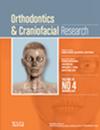Assessment of hard and soft tissue thickness at mandibular symphysis in skeletal Class III patients with different vertical patterns
Abstract
Introduction
This study aimed to assess the bony and soft tissue parameters at mandibular symphysis among skeletal Class III patients with different vertical growth patterns, using cone-beam computed tomography (CBCT).
Materials and Methods
CBCT images of 60 skeletal Class III non-growing patients were evaluated (mean age 24.9 ± 8.4 years). Study samples were classified into three facial types based on the mandibular plane angle (SN-MP angle): low, normal, and high angle. The bony and soft tissue parameters at the mandibular symphysis were evaluated.
Results
Among hard tissue variables, symphysis and pogonion width were significantly narrower in the high-angle group (P < .05). The thickness of the buccal cortex at pogonion was also significantly thinner in subjects with high angles (P < .01). Symphysis height showed an increasing tendency from the low-angle to the high-angle group. However, no significant differences were found in chin width and height according to vertical patterns. Across all soft tissue measurements, the low-angle group exhibited the highest thickness, which gradually decreased in the high-angle group. Statistically significant differences in soft tissue thickness were observed at Menton (Me) and Gnathion (Gn) (P < .05). A significant negative correlation was observed between the SN-MP angle and the thickness of both hard and soft tissues.
Conclusions
In skeletal Class III subjects, significant differences existed in both hard and soft tissues at the mandibular symphysis, depending on the vertical patterns. These results provide a comprehensive evaluation of symphyseal area, which can aid clinicians in identifying appropriate treatment approaches, especially for combined orthognathic and orthodontic treatment.

 求助内容:
求助内容: 应助结果提醒方式:
应助结果提醒方式:


